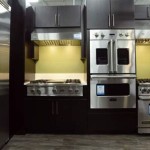Removing the Wall Between the Kitchen and Dining Room: A Comprehensive Guide
The removal of a wall separating a kitchen and dining room is a common home renovation project. This architectural modification often aims to create a more open, integrated living space, enhancing both functionality and aesthetic appeal. However, the process involves careful planning and execution to ensure structural integrity, adherence to building codes, and a successful final outcome. This article provides a comprehensive overview of the considerations, steps, and potential challenges associated with removing a wall between a kitchen and dining room.
Before embarking on this project, a thorough evaluation of the existing structure is crucial. This evaluation should include determining whether the wall is load-bearing, understanding the location of any electrical wiring or plumbing within the wall, and assessing the overall condition of the surrounding area. Ignoring these preliminary steps can lead to unforeseen complications and costly repairs.
The structural integrity of the wall is paramount. A load-bearing wall supports the weight of the floors or roof above. Removing a load-bearing wall without proper support can result in structural failure, which could compromise the safety of the building. Therefore, engaging a qualified structural engineer is essential to determine the wall's function and design a suitable support system, such as a beam, if necessary.
Furthermore, concealed within the wall may be electrical wiring, plumbing pipes, or HVAC ductwork. Identifying these elements before demolition is critical to prevent damage and potential safety hazards. A licensed electrician and plumber should be consulted to reroute or modify these services as needed.
Building codes and permits also play a significant role in this type of renovation. Local building codes dictate the requirements for structural modifications, electrical work, and plumbing alterations. Obtaining the necessary permits ensures that the project complies with these regulations and prevents potential legal issues down the line. Failure to obtain permits can result in fines, project delays, and even the requirement to restore the wall to its original condition.
The overall design plan should consider the new layout and functionality of the combined space. This includes determining the placement of appliances, furniture, and lighting to optimize the flow and usability of the area. The design should also address aesthetic considerations, such as flooring, paint color, and décor, to create a cohesive and visually appealing space.
Key Considerations Before Demolition
Prior to the physical removal of the wall, several critical steps must be addressed. Failing to adequately prepare can lead to complications, delays, and increased costs. These considerations span structural, electrical, plumbing, and logistical domains.
The first step is confirming the wall's load-bearing status. Consult a structural engineer to determine if the wall is supporting any structural weight above. If it is, a properly engineered beam and support system are required to maintain structural integrity. This system must be designed to handle the load previously supported by the wall. The engineer will specify the size, material, and installation method for the beam, as well as the necessary support posts or columns.
The second step involves identifying and rerouting any existing electrical wiring, plumbing pipes, or HVAC ducts within the wall. A licensed electrician and plumber should assess the situation and develop a plan to safely reroute these services. This may involve disconnecting the existing wiring and plumbing, running new lines or pipes, and reconnecting them to the appropriate fixtures or appliances. All work should be done in accordance with local building codes and safety regulations.
The third step is obtaining the necessary building permits from the local municipality. This process typically involves submitting detailed plans of the proposed renovation, including the structural modifications, electrical work, and plumbing alterations. The permit application will be reviewed by building officials to ensure that the project complies with all applicable codes and regulations. Once the permit is approved, the work can proceed.
Finally, consider the dust and debris generated during demolition. Protecting adjacent rooms with plastic sheeting is essential. Also, establish a clear pathway for removing debris and ensure proper disposal methods are in place. Safety gear, including eye protection, gloves, and respirators, should be worn by all involved in the demolition process.
The Demolition Process
Once the preparatory steps are completed, the physical demolition of the wall can begin. This process should be approached systematically and with caution to minimize damage and ensure safety. The tools and techniques used will depend on the type of wall construction and the presence of any utilities.
The first step is to disconnect any remaining electrical wiring or plumbing within the wall. Even after rerouting, there may be remnants of the old systems that need to be safely disconnected. A licensed electrician and plumber should handle these disconnections to avoid electrical shocks or water leaks.
Next, protect the surrounding area with drop cloths and plastic sheeting to minimize dust and debris. Covering furniture, flooring, and other surfaces will prevent damage and make cleanup easier. Consider using a HEPA filter air purifier to help remove airborne particles.
The demolition itself can be accomplished using a variety of tools, depending on the wall's construction. For drywall walls, a utility knife can be used to score the seams and a hammer and pry bar can be used to remove the panels. For plaster walls, a demolition hammer or sledgehammer may be necessary. If the wall contains brick or concrete blocks, a jackhammer or demolition saw may be required.
When removing the wall, work from the top down to reduce the risk of falling debris. Be careful not to damage any adjacent walls or ceilings. If the wall is load-bearing, ensure that the temporary support system is in place before removing any structural elements.
After the wall is removed, clean up the debris and dispose of it properly. Sort the materials for recycling whenever possible. Inspect the area for any damage to the surrounding walls, floors, or ceilings. Repair any damage promptly to prevent further problems.
Post-Demolition Considerations and Finishing Touches
Following the demolition, a series of finishing touches are necessary to complete the project and create a seamless transition between the kitchen and dining room. This phase includes addressing structural support, surface preparation, and aesthetic enhancements.
If a load-bearing wall was removed, the installation of the support beam is crucial. The beam must be installed according to the structural engineer's specifications, ensuring proper alignment and support. The support posts or columns should be securely anchored to the floor and ceiling. The beam and support structure should be inspected by the structural engineer to verify its integrity.
Next, prepare the surfaces for finishing. This may involve patching any holes or cracks in the surrounding walls and ceilings, sanding down rough edges, and applying a primer coat. The goal is to create a smooth, even surface that is ready for painting or other finishes. If the flooring needs to be matched or extended, this is the time to do it. Uneven flooring can create a tripping hazard and detract from the overall appearance of the space.
Finally, add the finishing touches to complete the renovation. This includes painting or wallpapering the walls, installing new lighting fixtures, and adding decorative elements. Pay attention to the details, such as the trim around the doorways and windows, the hardware on the cabinets, and the placement of the furniture. The overall design should create a cohesive and inviting space.
Consider the transition between the kitchen and dining room. A breakfast bar or island can visually define the two spaces while maintaining an open feel. The colour schemes and design elements should complement each other to create a harmonious look.
Removing a wall between a kitchen and dining room can transform a home, creating a more open and functional living space. Careful planning, adherence to building codes, and attention to detail are essential for a successful outcome. By following these guidelines, homeowners can create a stunning and valuable addition to their home.

Remove Wall Between Kitchen And Dining

Tear Down The Wall

Kitchen Remodel With Wall Removal Portside Builders

Will This Kitchen Dining Wall Removal Make A Big Difference

Kitchen Remodel With Wall Removal Portside Builders

Things To Consider Before Removing The Wall Between Your Kitchen And Dining Room

Removing Partition Wall Between Kitchen And Dining Room Youtube

Tear Down The Wall

Benefits Of Wall Removal Embracing A Spacious And Modern Home Load Bearing Pros

Tearing Out A Half Wall Between Kitchen And Family Rooms House Of Hepworths
See Also








